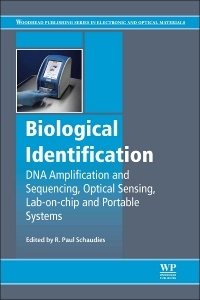Biological Identification DNA Amplification and Sequencing, Optical Sensing, Lab-On-Chip and Portable Systems Woodhead Publishing Series in Electronic and Optical Materials Series
Coordonnateur : Schaudies R. Paul

Biological Identification provides a detailed review of, and potential future developments in, the technologies available to counter the threats to life and health posed by natural pathogens, toxins, and bioterrorism agents. Biological identification systems must be fast, accurate, reliable, and easy to use. It is also important to employ the most suitable technology in dealing with any particular threat. This book covers the fundamentals of these vital systems and lays out possible advances in the technology.
Part one covers the essentials of DNA and RNA sequencing for the identification of pathogens, including next generation sequencing (NGS), polymerase chain reaction (PCR) methods, isothermal amplification, and bead array technologies. Part two addresses a variety of approaches to making identification systems portable, tackling the special requirements of smaller, mobile systems in fluid movement, power usage, and sample preparation. Part three focuses on a range of optical methods and their advantages. Finally, part four describes a unique approach to sample preparation and a promising approach to identification using mass spectroscopy.
Biological Identification is a useful resource for academics and engineers involved in the microelectronics and sensors industry, and for companies, medical organizations and military bodies looking for biodetection solutions.
Part I: Technology for DNA and RNA analysis of pathogens 1. Nucleic acid sequencing for characterizing infectious and/or novel agents in complex samples 2. Multiplexed, lateral flow, polymerase chain reaction (PCR) techniques for biological identification 3. Isothermal amplification of specific sequences 4. Bead array technologies for genetic disease screening and microbial detection
Part II: Lab-on-chip and portable systems for biodetection and analysis 5. Electrochemical detection for biological identification 6. Conductometric biosensors 7. Bio-chem-FETs: field effect transistors for biological sensing 8. Microfluidic devices for rapid identification and characterization of pathogens
Part III: Optical systems for biological identification 9. Optical biodetection using receptors and enzymes (porphyrin-incorporated) 10. Overview of terahertz spectral characterization for biological identification 11. Raman spectroscopy for biological identification 12. Lidar (Light Detection And Ranging) for biodetection
Part IV: Sample preparation and mass spectrometry-based biological analysis 13. Electrophoretic approaches to sample collection and preparation for nucleic acids analysis 14. Mass spectrometry-based proteomics techniques for biological identification
- Covers DNA sequencing of pathogens, lab-on-chip, and portable systems for biodetection and analysis
- Provides an in-depth description of optical systems and explores sample preparation and mass spectrometry-based biological analysis
Date de parution : 05-2014
Ouvrage de 470 p.
15.5x23.2 cm



